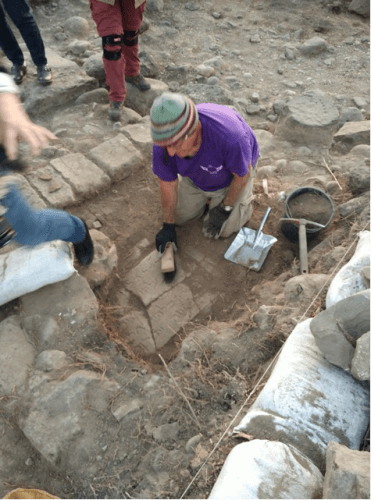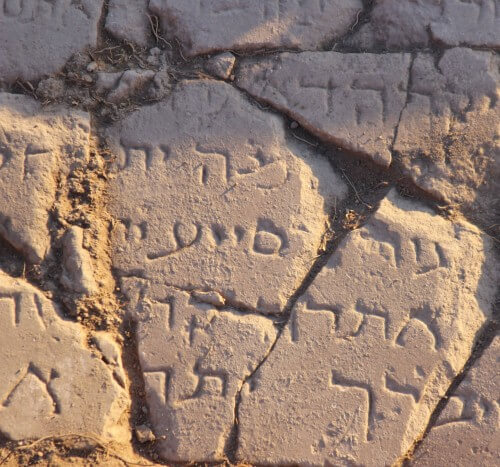This first evidence of the existence of a Jewish settlement strengthens the explanation, which until now was in the realm of folklore, that the settlement is "Korsi" which is mentioned in the New Testament as one of the places where Jesus visited and performed his miracles


An inscription in Hebrew letters engraved on a large 1,500-year-old marble slab, the like of which has not been found in the whole country, was discovered in excavations in the Khov Kursi National Park on the eastern shore of the Sea of Galilee, thus confirming for the first time that the ancient settlement was Jewish or Jewish-Christian. "This first evidence of the existence of a Jewish settlement strengthens the belief, which until now has been in the realm of folklore, that the settlement is 'Korsi' - the place where Jesus visited and performed the famous 'Miracle of the Pigs' according to the New Testament," said Prof. Michal Artzi from the Hatter Laboratory at the institute for Marine Studies by Prof. Recanati at the University of Haifa, which is managing the excavation together with Dr. Haim Cohen and in cooperation with the Antiquities Authority, Natural Heritage and Gardens.
The existence of an ancient settlement at the site, in the northeast of the Kinneret, was already known in the 1980s, when Prof. Aver Raban from the University of Haifa, together with Mandel Nun from Kibbutz Ein Gav, found remains of a large breakwater under the sea as part of a survey they conducted. Later, not far away, the remains of a city were found, the main features of which were those of a Christian site from the Byzantine period (fifth century AD). The entire complex became a national park in XNUMX and the place was given the name "Coursy" after a Syrian village that was nearby. The popular assumption was that this was the settlement of "Korsi" or "the land of the fences" mentioned in the New Testament, as the place where Jesus came as part of his journeys in the Sea of Galilee and where he performed the miracle in which he cast out demons and transferred them into pigs (the miracle of the pigs).
The sharp drop in the level of the Kinneret allowed the researchers of the Hatter Laboratory from the Reknati Institute of Marine Studies of the University of Haifa to return to the excavations in the area of the breakwater, thanks to the support of the AVERY-TSUI Foundation from the USA, and in cooperation with the Antiquities Authority and the Nature and Parks Authority. They quickly realized that the ancient harbor was much larger than they had thought until now - and that it may be part of the Byzantine site, but it may be a nearby and separate settlement. It is possible that the ancient city of Susita, which is also being excavated and studied by researchers from the University of Haifa and is not far away, also used the services of the port.
But nothing prepared them for the extraordinary discovery: a marble slab made of one piece measuring 150 x 70 cm with an inscription in the Aramaic language in Hebrew letters, when the researchers were already able to read two of the words: "Amen" and "Marmariah" - which apparently is the word " There is", but among the scholars there are those who believe that the word alludes to Mary, the mother of Jesus. According to the researchers, a Hebrew inscription from 500 AD indicates a Jewish settlement or a mixed settlement. In light of this, they added, the most accepted assumption is that 500 years earlier the settlement was completely Jewish. "The existence of a Jewish settlement on the eastern shores of the Kinneret is a very rare thing. To this day, we have had no proof that Jewish settlements, which disappeared over the years, actually existed at that time on the shores of the Sea of Galilee, except for the tower." Prof. Artzi said.
The combination of all the findings led the researchers back 2000 years, to the journeys of Jesus in the region according to the New Testament, and especially to the "land of the fences" aka "Korsi". According to the New Testament, Jesus arrived at "Korsi" when he crossed the Sea of Galilee from one port to another. According to the researchers, since it is the only port in the area, together with the inscription that testifies to Jewish roots, they constitute archaeological evidence that this may be the "Korsi" of the New Testament.
Beyond the fact that the inscription testifies to Jewish roots for the settlement, it is unique in other respects - and in fact it is the first of its kind found in Israel. Most of the dedication plaques from this period were made of mosaic and were embedded in the floor of the compound and this is the first dedication plaque of its kind engraved on marble, which was specially ordered from Greece. The inscription was found at the entrance to an inner room inside a building that was probably a synagogue. "The dedication consists of eight lines, meaning it is very detailed or extensive. Usually you don't find so many words in Hebrew letters engraved in stones, therefore the person to whom the inscription was dedicated had a huge influence on the local people. There is no equivalent to such a detailed and expensive dedication in the archaeological discoveries found so far in Israel," says Prof. Artzi.
Volunteers from Israel and abroad, mainly China and Taiwan, and students from the Haifa University's international program participate in the excavations at the Kursi Beach National Park, and ground-penetrating radar and other tests are conducted in collaboration with Dr. Yossi Salomon from the Technion and researchers from Spain and France. Volunteers from Olafna Benov also participated as part of the "Estate" project of the Antiquities Authority. Other archaeological findings at the site include pottery and a clay candle with fish on it, and another one with a ship on it.

3 תגובות
In terms of Jewish history, this is the period of the Jerusalem Talmud in the Land of Israel and the majority of the Jewish settlement was concentrated in the Galilee.
No wonder, then, that there was a synagogue in the place with such an inscription. At the same time - the discovery itself is rare because imported marble tombstones were returned in later periods and the inscriptions were defaced.
How is a Jewish settlement called Kursi. Kursi is a chair in Arabic. I always thought it was called a chair beach because there are chairs there. Now I learn that it is a Jewish settlement.
Beautiful. Contrary to the official policy of some history professors to greatly underestimate the value of the Jewish settlement in Israel. The year 500 is the destruction of the Western Roman Empire, the final entry into the Middle Ages, and the rise of the Byzantine Empire. Although not Justinian. The destruction of the house took place soon in 50 CE, and Jesus was active in 30, and there is evidence even in the Talmud of the existence of a man of this name that fits very well with his description in the New Testament, only from a negative point of view.